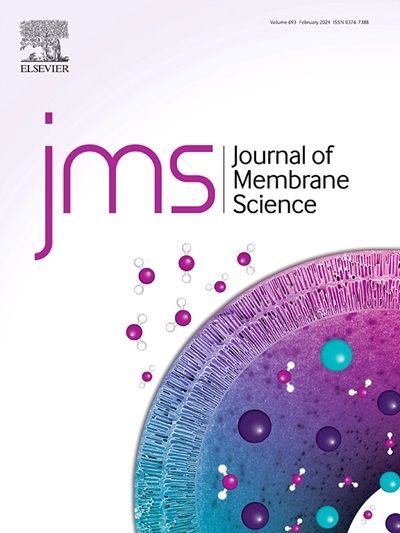Unveiling the role of polypropylene interactions with lithium fluoride solutions: Insights into crystallization dynamics and membrane behaviour
IF 8.4
1区 工程技术
Q1 ENGINEERING, CHEMICAL
引用次数: 0
Abstract
The escalating demand for lithium, driven by its pivotal role in electronic devices and lithium-ion batteries, underscores the urgent need for sustainable lithium recovery methods. Recycling lithium from spent batteries represents a promising strategy to meet this demand; however, a detailed understanding of crystallization processes in the presence of functional interfaces remains largely unexplored. In this study, we present a novel investigation into the role of polypropylene (PP) membranes in controlling the crystallization dynamics of lithium fluoride (LiF) from ionic solutions.
Using a combined computational and experimental approach, molecular dynamics (MD) simulations are performed to compare bulk crystallization with crystallization occurring at the membrane interface. Our results reveal that the membrane deeply influences the crystallization process, increasing induction times and reducing nucleation and growth rates, which indicates a more controlled and structured crystal formation. Notably, the presence of the membrane enhances the crystallinity of the formed crystals, likely due to its structuring effect on the surrounding ionic environment. To assess the impact of the ionic solution on the membrane, we further analyzed morphological parameters and conducted experimental validation. The polypropylene membrane demonstrated exceptional robustness, retaining its structural stability and hydrophobicity, as confirmed by contact angle measurements, even after prolonged exposure to the solution. Experimental trends in nucleation times, crystal morphology, and membrane behavior align closely with the computational findings, reinforcing the reliability of our results.
This study introduces a novel perspective on the interactions between membranes and crystallizing ionic systems, providing fundamental insights into the role of membrane interfaces in influencing crystallization dynamics. The findings pave the way for optimized membrane-based processes, offering valuable knowledge to advance sustainable lithium recovery technologies.

求助全文
约1分钟内获得全文
求助全文
来源期刊

Journal of Membrane Science
工程技术-高分子科学
CiteScore
17.10
自引率
17.90%
发文量
1031
审稿时长
2.5 months
期刊介绍:
The Journal of Membrane Science is a publication that focuses on membrane systems and is aimed at academic and industrial chemists, chemical engineers, materials scientists, and membranologists. It publishes original research and reviews on various aspects of membrane transport, membrane formation/structure, fouling, module/process design, and processes/applications. The journal primarily focuses on the structure, function, and performance of non-biological membranes but also includes papers that relate to biological membranes. The Journal of Membrane Science publishes Full Text Papers, State-of-the-Art Reviews, Letters to the Editor, and Perspectives.
 求助内容:
求助内容: 应助结果提醒方式:
应助结果提醒方式:


